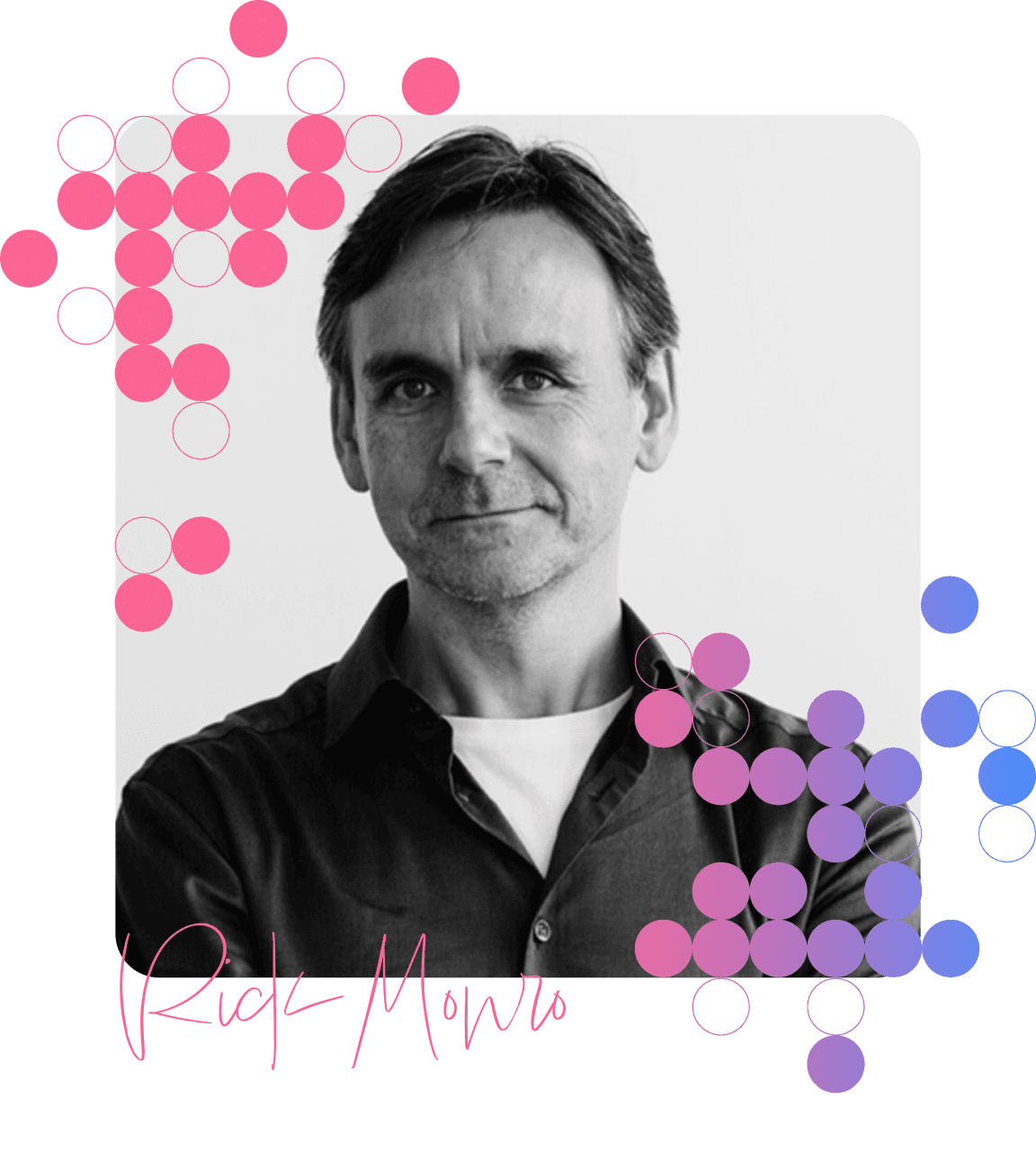Rick Monro’s career as a designer began in graphic design, moved on to the early halcyon days of client-driven web design, before long stints in both dedicated web and UX agencies prepared the ground for his current role as Director of UX at Invicti Software, an enterprise security software company.
With such varied design experience, when Rick says many designers are dismissive of enterprise software, you know it’s not just a case of sour grapes.
“Enterprise software gets a bad rap from designers who probably don't or haven't worked in it. The difference is the nature of the end user. If you're designing a consumer app, all of the decisions belong to the person who owns the phone. So, if I download a to-do app, for instance, and I don't like it, I'll get rid of it and I'll try another one. The reason why I like it could be very heavily influenced by the feature set, or the user experience. In that scenario, the user experience, when we're dealing with a singular user becomes much more significant.”
In contrast, working on complex software for businesses, you have to consider the needs of the broader customer organization, while also understanding that your tool can be one of up to a dozen that they are using to achieve a broader outcome or set of results.
“More than being able to align with a singular user's needs, you need to align with the needs of an organization,” explains Rick. “Yes, it needs to be usable but it also needs to fit in with that organization's workflows or environments or integrations. And a lot of the time it needs to fit in with that organization's culture overall. I'm not trying to paint this as somehow more grown up or more advanced, it's just different.”
For designers working on these kinds of products, it means reassessing priorities and realizing you are serving niche users, who have a lot of complex work to do and often have to make a lot of quick decisions. Rick points to the example of Asana, the project management tool which famously, or perhaps infamously, has animated unicorns and narwhals flash across the screen when a user completes a task or hits other goals.
“More than being able to align with a singular user's needs, you need to align with the needs of an organization, it needs to be usable but it also needs to fit in with that organization's workflows or environments or integrations.”
Play audio clip
(0:29)
“The idea of one of the users of the applications I'm involved in, seeing a narwhal leap across their screen would just be daft. It's a lot more stark and very much task-focused. You have to be a lot more crisp and clinical in terms of the way that you are working, understanding what that person is trying to achieve and what success looks like for them - and those around them.”
Clearly the same principles of design apply that Rick would have used previously in his career, but as he puts those principles apply very differently when “an organization needs to adopt a product versus somebody needs to go and buy something off Asos or whatever. It's just a whole different proposition.”
Sometimes that means his design muscles are exercised not in making a feature visually attractive but in influencing how the feature flows, or presenting it in a more minimalist way.
“We could really go to town on this and embellish this and do all the things we would love to do [as designers], but how much value is that actually going to add for the user in this particular context? Much more of the work in enterprise involves deeply understanding the workflows, getting the user from A to B and all the myriad other possibilities in between.”
For design leaders that means that UX may not always be the primary consideration, which requires trust in the multi-disciplinary team that you are working with.
“The best setup that I'm usually involved in is when an engineering lead, a product manager and a design lead are a very tight group and can align on what’s important. So very crudely speaking the whole feasibility / viability / desirability piece – although they don't align neatly with those three functions – if those are all in the mix, and there's that nice spot at the center of the Venn diagram that we arrive at, that's a successful result. So it's not design-centric. There are other priorities that come into play.”
“You have to be a lot more crisp and clinical in terms of the way that you are working, understanding what that person is trying to achieve and what success looks like for them - and those around them.”
Play audio clip
(0:10)
At Invicti, Rick says he is fortunate to work with cross-functional partners who really appreciate the value that UX can bring to the table, but are also able to make judgments about when it’s not going to add as much value. He believes that simply comes from engineering, product management and design leaders fundamentally respecting each other’s craft.
“If there's a customer who needs something really quickly that will unlock or, or free up that team in their organization to do something, it's probably best that just gets done. We can talk to them later about how it might be improved. Some of it is being agile and knowing that you can ship and learn. Agile is sometimes anathema to good design, and while tension remains between UX and Agile, dogmatism of any sort isn't great. Even when it's design dogmatism.”
Part of the reason that Invicti can be so agile is the size of the company – it’s just under 400 people globally – which also means that while designers are embedded on teams with engineers and product managers, it’s still relatively easy for the design team to come together as a group who know each other and what they are all working on.
“I don't know how many designers IBM or Microsoft have, or even lesser organizations in size, but design becomes more of a community of practice where the get-togethers try to create alignment around how design is being done right across the organization. It's very difficult to coordinate. We're still small enough that we don't lose sight of everything that's being done.”
Although Rick is now embedded in the enterprise software world it hasn’t necessarily been an obvious path to get there. His career began in Belfast in the mid-90s, at Building Design Partnership, an architecture-led multidisciplinary office with locations all around the UK. Rick soon realized that architecture-led meant the other disciplines were in service to architecture. “I was really working on signage systems, and latterly exhibition design,” laughs Rick. Although there were highlights, such as working on an exhibition that adjoined the Book of Kells in Trinity College, Dublin (“Suddenly, my folks understood what graphic design was, so that was great.”) Like many of today’s UX leaders Rick had begun to get more interested in the nascent web. Aware of his self-observed limits as a graphic designer, Rick saw the potential, even in the badly designed web of the late 1990s, to get in on the ground floor of a new communications medium.
“It occurred to me, if graphic design isn't going to work out, this is a whole new communications medium which will probably be around for a few years. Who knows? Maybe I should learn how to design for it. That then set off a spark that I hadn't had earlier in my design career. It was really just having fun, just learning that medium.”
Rick enjoyed the freedom that the web offered, compared to the natural physical limitations of print design, which led to him getting more commissions for private work. Although it might sound crazy to say it out loud in 2023, 20 years ago there was little to no focus on the needs of the user.
“In those days, it was ‘flatter the client’, really give their logo a lot of love, maybe a few bevels and put some nice imagery in there. And that was it, because that greased the wheels of the sausage machine.”
After a stint with Tibus as a web designer, Rick got his first taste of product design when he took a role as an interface designer with a Belfast startup, Ecom. If web work at the time was more about flexing your Photoshop skills to create something visually impressive, at Ecom he got to think about more complex online products – everything from an inline MP3 player to an expense management system.
“That idea of interface, in a pure sense, started to enter my thinking. Literally this button does this thing,” Rick laughs. “It wasn't just a series of hyperlinks to take you to more content or to a contact form. It was interface as a literal touchpoint for the functionality beneath it. Of course, that's what websites are but I certainly hadn't thought about it in that way before.”
“But the ones that did were kind of thrilled to suddenly be a part of the process and see how the sausage was made, if you like.”
Play audio clip
(0:07)
In the intervening years web design had become more user-focused with a focus on problem solving that had been lacking before. Rick returned to agency life, initially web design and subsequently a UX agency. Macromedia Flash was a dominant tool, and while that era might be derided by design purists now, Rick isn’t afraid to admit he learned a lot from that period.
“If you provided a company with a way of doing something that they couldn't otherwise do, then you're solving a problem. Particularly if you get into solving business problems. Like how does a salesman go on site, without a web connection, and specify for example a quite complex arrangement of choices around a PVC door? (As one example that's just etched in my memory because there were so many late nights spent on it.) That is assisting a business, in ways that a website was not doing at that time.”
Around this time Rick was also immersing himself in design thinking and trying to bring his new found knowledge to bear for clients. He still talks fondly of what he learned at this time – whether through Design Twitter, which was in its heyday at the time – or Jesse James Garrett's trailblazing work on user experience, or Stewart Brand’s Pace Layers Model (via Jorge Arango’s book ‘Living in Information’), which suggested strategies should evolve slowly, although tactics will probably change very quickly.
Bringing user-centered design to his agency work was transformative in terms of the client relationship and the quality of the work.
“Some clients got it and some didn't, but the ones that did were kind of thrilled to suddenly be a part of the process and see how the sausage was made, if you like.”
A common refrain from those who didn’t get it, was the request to design something ‘award-winning’, which in Rick’s experience is always a red flag.
Fittingly for someone who thinks deeply about his craft, a parallel path of Rick’s career has been time spent sharing his knowledge in an education setting. He’s taught students of interactive design courses at Ulster University and is very clear about what students embarking on their career need to hear.
“You're really just capping [their education] by saying ‘hello, here's me from the outside world, here to tell you that what you've been learning has been the right thing’. Trying to throw in some additional nuggets that maybe they hadn't heard and just maybe create some kind of spark or plant a seed in them that they'll pick up on later.”
In contrast, his work with technology hub Catalyst, and working alongside Belfast-based design consultancy Big Motive, was very different and involved the application of design thinking to startup ideas.
“The great thing about that particular course is that you have folks coming in who may have been sure that they were going to change the world, set the world alight with their idea. It introduces design thinking to ask “What problem are you trying to solve? How are you solving it?”
“Just inspecting their idea and stress-testing it from different angles. The best thing that can happen to some of those folks is that they leave knowing that the idea wasn't what they thought it was. Maybe they've got to go away and rethink it, pivot, maybe start again. But that is a good outcome, rather than spend a few years chasing something non-viable.”
Not surprisingly, Rick is upbeat about the future of UX and doesn’t think anyone should be pining for the good old days, given the need for the discipline to continue evolving.
“I'm really intrigued to see what UX becomes as a practice, and it will almost certainly get another name somewhere along the way. Bear in mind we've been through human factors, we've been through user-centered design. I've no doubt that it'll morph into another term, which eventually will also lose its meaning. But the core – design fit for humans – remains the same.”
























